T. G. Hawkes Cutting House
American Brilliant Glass Education and Research - HBG
The Patented Patterns Chrysanthemum, Panel and Willow
The Patented Chrysanthemum Pattern by T. G. Hawkes & Company
The Chrysanthemum pattern, pat. no. 20,257, is shown below as the patent's drawing, and as cut on a finger bowl and on a carafe. Motifs: Cane, Fan, Hobstar, "Middlesex" Hobstar, Single Star, Split, Strawberry Diamond. Two views of the carafe are necessary in order to show the entire patern.
Finger bowl: H = 4.5" (11.4 cm), H = 2.25" (5.7 cm), selling price unknown (Images: Internet). Carafe: H = 7.5" (19.0 cm), base D = 5" (12.7 cm), wt = 3.25 lb (1.5 kg). Sold for $300 in 1989.
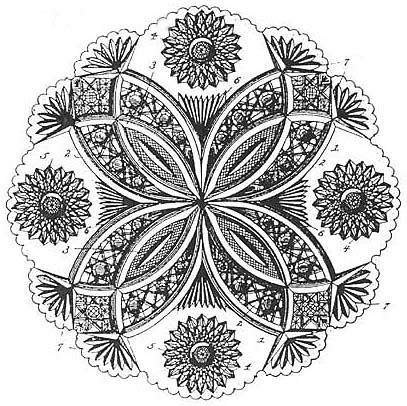
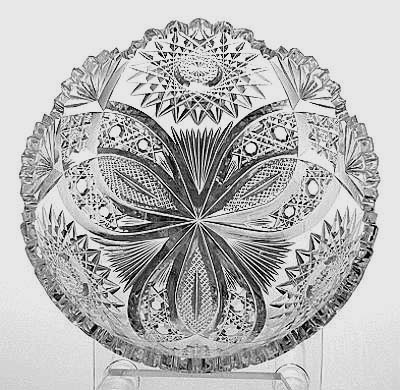

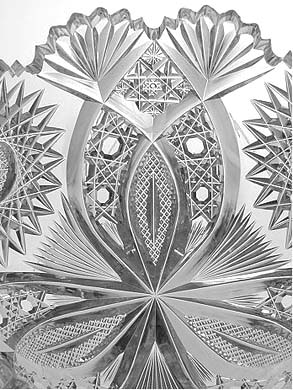

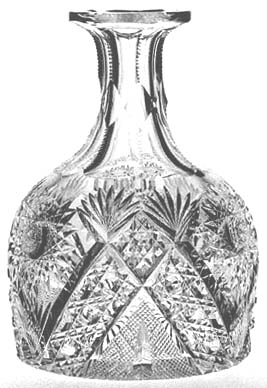
In spite of the fact that it was extensively cut over a long period of time, the Chrysanthemum pattern is considered scarce today. As a result, asking prices are well above average. One convenient way to circumvent this situation is to consider acquiring the pattern on a small object. The typical 7"D individual ice cream/cake plate is ideal, but that form is very popular, with the result that prices are usually quite high. An alternative is the finger bowl, an excellent example of which is shown above.
Two myths about finger bowls should be mentioned: Firstly, they do not invariably have smooth (uncut) rims. As shown here the rim can occasionally be cut in the scalloped-and-se style that is typically found on berry bowls. And secondly, finger bowls and underplates (if available) were sold separately. Consequently, a bowl without an underplate is not considered "incomplete". Sometimes matching underplates are nowhere to be found in the catalogs that contain finger bowls; presumably their companies' matching 7"D plates were enlisted to do double duty. But they too could be dispensed with. The hostess would simply place the cut-glass finger bowl on a ceramic underplate, separated by a doiley. Today a finger bowl and underplate on the table is something of an anachronism. The last time the writer was present with a set was in the dining car of the Twentieth Century Limited! As an eight-year-old he was mightily impressed.
Although it is often stated that the Chrysanthemum pattern was awarded the grand prix at the Paris Exposition of 1889, this is not true, for two reasons:
1. The prize, which was won by Hawkes, as well as by several other glass companies, was granted "for the total exhibit, not for any one piece, pattern, or type of glass" (Spillman 1996, p. 236). (For this reason the Grecian pattern, which is frequently paired with the Chrysanthemum pattern as a "first prize winner", also won no prize.)
2. The Chrysanthemum pattern is not found on the inventory lists that accompanied the glass Hawkes sent to Paris. (The Grecian pattern, on the other hand, frequently appears on the lists.) This is not surprising when it is realized that a full year passed before the patent application for the Chrysanthemum pattern was submitted to the USPTO, a full year after the Paris Exposition closed in October 1889. It is unlikely that the pattern existed anywhere during the summer of 1889, except, perhaps, in the mind of T. G. Hawkes.
The Patented Panel Pattern by T. G. Hawkes & Company
This drawing of the Panel pattern, which accompanies patent no. 40,195 at the USPTO, shows a bowl's cut surface. As such, the pattern, which appears deceptively flat when viewed on its uncut surface (and which is the way it is shown in most cases, including the two photographs in this file) -- has great depth. Note the thickness of the octagonal shapes that support the 8-, 12-, and 16-pt Brunswick stars.
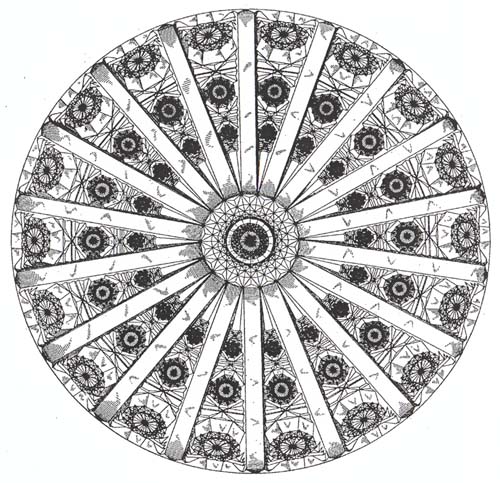
(Hawkes cut at least one "variation" of the Panel pattern. It is shown on a bowl in Spillman [1996, p. 73] who calls the pattern Panel. However, some of the Brunswick stars have been changed to hobstars, and stars and strawberry [fine] diamonds have been added to the pattern. In addition, the channel cuts are no longer evenly spaced and the bowl's rim has been altered to the familiar scalloped-and-toothed design. The writer feels that all this is more than just a variation. It is probably a different pattern with an as-yet undiscovered name.)
Close-up photographs of Hawkes' Panel pattern as cut on a no. 700 bowl. D = 9" (22.9 cm), H = 4" (10.2 cm), wt = 6.7 lb (3.0 kg). Sold for $7,320 at an eBay auction in 2004 (Images: Internet).
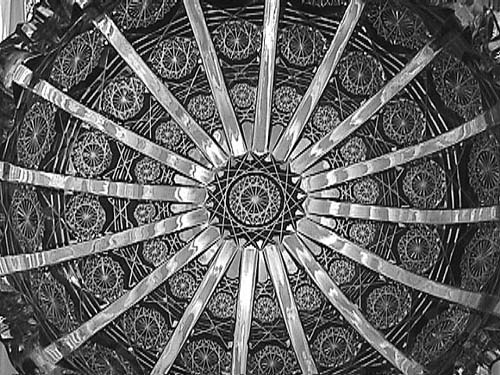
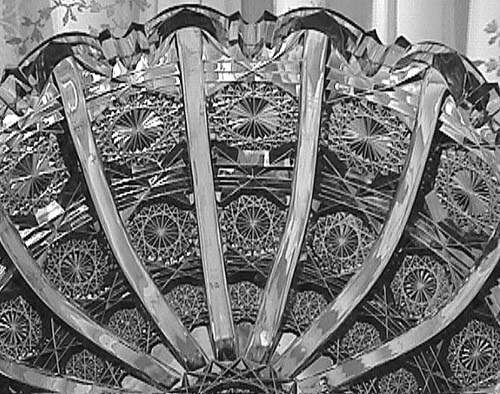
The Patented Willow Pattern by T. G. Hawkes & Company
Patented in 1911 as pat. no. 41,153, the Willow pattern was originally known among collectors as "Lattice and Rosettes" until about 1979. The following illustrations show the design as submitted by Hawkes to the Patent Office, followed by two examples:
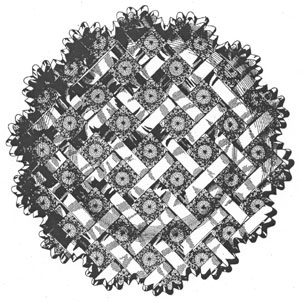
Example No. 1: An ice cream tray cut in the Willow pattern. L = 13.5" (34.3 cm), W = 9.0" (22.9 cm), wt = 4 lb (1.8 kg). Sold for $8,550 at an eBay auction in 2004 (Images: Internet).


Example No. 2: A 12"D tray that was offered for sale on the Internet for $29,500 in August 2005.
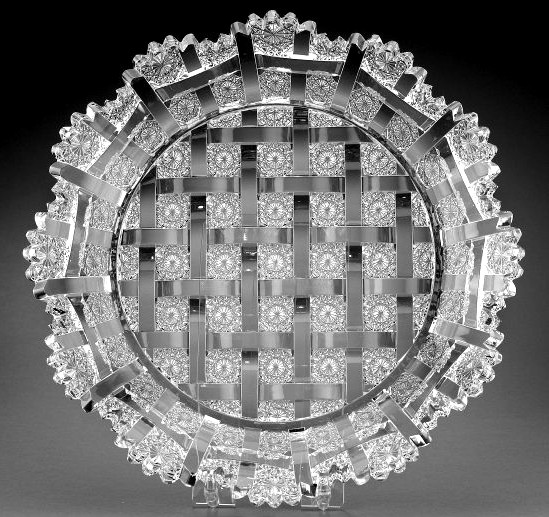
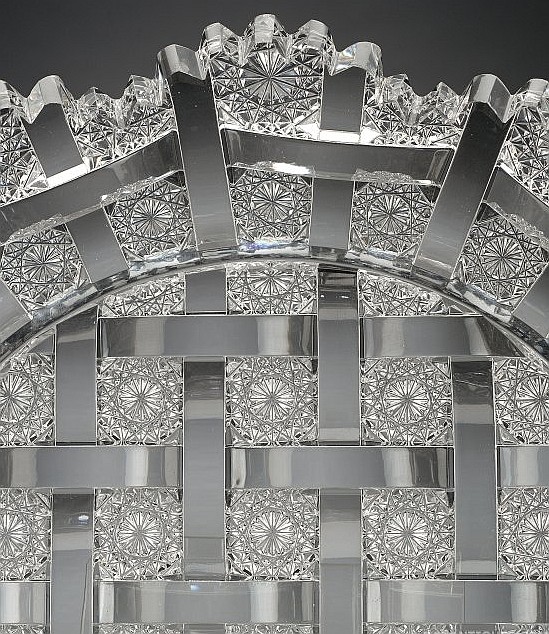
Updated 10 Sep 2007
Content courtesy of Warren and Teddie Biden and Jim Havens